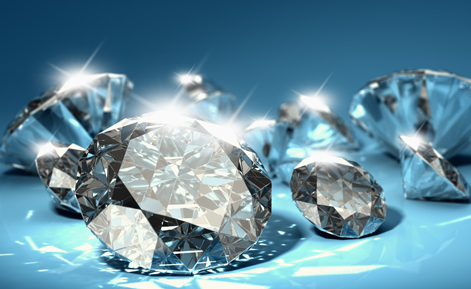How to Tell Real Diamond Jewelry From Look-Alikes
In the world of diamond jewelry today it can be difficult to identify a real diamond from imitations, especially with advances in creating cubic zirconia and moissanite, the diamond doppelgängers. If you are trying to figure out exactly what type of stone you have or want to insure what you think is a diamond, it’s best to test it. So in honor of this exceptional April birthstone and ‘National Look-Alike Day’ we want to help explain some of the simple tests you can do while out shopping or on your own jewelry at home to discover if a diamond is real or not.
Diamonds
True diamonds are the hardest, naturally-occurring substance on Earth and have a brilliance of light refraction unmatched by any other gemstone. Diamonds are held to high standards and if they are authentic will usually come with a certificate by one of the diamond grading authorities like the GIA (Gemological Institute of America) or the AGSL (American Gem Society Laboratories). At our Gilbert showroom the loose diamonds are all GIA reported and registered so if you want to see what the certificate looks like we would be happy to show you an example. If you have the GIA diamond certificate of authenticity then you can be assured you have a real diamond but with no certificate here are some things you can try.
DIY: Test for Diamonds
A quick and easy test would be to look closely to see if there are any scratches on the surface of the stone and if there are, it is not a diamond. If you find no scratches then another fast test is to use your breath and try to fog up the stone as you would to clean a pair of glasses. Because real diamonds are amazing heat conductors they do not ‘fog up’ so if you see the stone is very foggy as you pull it away to look at it then that could mean it is a cubic zirconia or moissanite.
Cubic Zirconia
Debuting in 1976, cubic zirconia or CZ as it is referred to, is the most well-known faux diamond in the world. CZ is usually colorless and appears flawless to the naked eye. It is a hard stone but not as hard as real diamonds, therefore, the scratch test mentioned above would expose a scratched stone as CZ.
DIY: Test for Cubic Zirconia
One test you can do with a loose stone is place it on its head, the non-pointed end, and try to make out words from a magazine or newspaper. Diamonds refract light so much that you can’t clearly read anything through them but cubic zirconia allows for a clearer view so if you can read the letters through the stone you probably have a CZ on your hands. If the stone is in a setting, another way to inspect it would be to take a magnifying glass and search for a stamp of C.Z. which obviously indicates the type of jewelry you have. If there is no visible stamp then one of the last things you could try would be to feel the weight of the jewelry. Cubic zirconia is almost twice as heavy as a diamond so if you have an authenticated diamond ring put it in the palm of your hand with the other ring in question and gently bounce them. If one feels heavier than the other then it could be a CZ. Obviously these tests are not always completely accurate so if you are at all unsure visit your trusted jeweler to double check.
Moissanite
This gemstone was actually discovered in Arizona by Henri Moissan, a French chemist who found traces of the stone in a meteor crater. It is extremely rare to find moissanite in nature so it is now engineered in labs to create the illusion and luster of diamonds.
DIY: Test for Moissanite
Although this gem is almost as hard as diamonds it does not refract light in the same way. If you have a loose stone, try coloring a dot on a piece of plain white paper and placing the point of the gem on top of it. A cloudy image of the dot or a circular reflection in the stone signifies you have a moissanite. Likewise, if you have a set stone and can see the bottom point of the stone when looking through the top then it is most likely moissanite. Again, these do-it-yourself tests are not fool-proof and if the stone is dirty in any way it could throw off the results.
Diamonds, CZ and moissanite, oh my!! Don’t get us wrong, they can all appear very beautiful and a well-made cubic zirconia or moissanite can be cost effective, but when you are paying for a diamond you want to know that you are getting a diamond. We want to help you ensure that you have what you paid for and, especially for any type of insurance you may be purchasing, that you know the true identity of your jewelry. If you still have questions after closely examining your jewelry or trying a few of these tests with differing results then come on by and your friendly Gilbert jeweler can test it for you.
